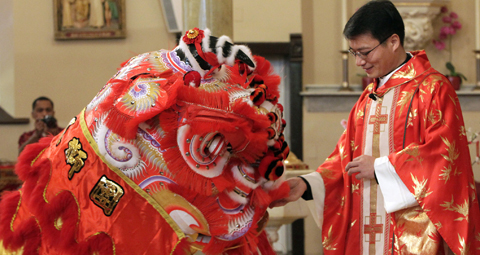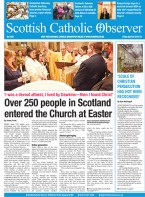February 15 | ![]() 0 COMMENTS
0 COMMENTS ![]() print
print

The Chinese Catholics making a home in Glasgow
In a special report Ross Ahlfeld sees first-hand a thriving Chinese Catholic community in Glasgow, and assesses the Church’s plight in the land of the dragon.
Many people might be surprised to know that Glasgow’s Chinese Catholics have a Mass in Mandarin at St Gregory Barbarigo’s Parish Church every few months, celebrated by London-based Fr Joseph Liang. The Maryhill church—named after an early Venetian missionary to China—also hosts a regular monthly Mass delivered in a mix of Cantonese, Mandarin and English.
Fr Allan Cameron at St Gregory’s describes the presence of the Chinese community within the parish as a real blessing, which reflects the modern face of the Church and the diversity of the wider community in Maryhill.
Indeed, if you’re looking for a real contemporary pilgrimage to a very modern church within an urban setting, then this is very much the pilgrimage for you.
Yes, St Gregory’s is very much a modern building but please do not confuse contemporary architecture with ugliness asthis is very much a sacred space. The use of concrete, rich cedar timbers, glass and lightcombine to give this holy space an atmosphere of peace and tranquillity.
Best of all is the walk to the Church from Hillhead underground station through theBotanic Gardens and out along the Kelvin walkway, where you can also explore the historic heart of Maryhill and the industrial heritage of the nearby Forth & Clyde Canal.
Visiting this interesting place of worship with its diverse congregation reminded me of an encounter with a fascinating Chinese lady who told me all about how she came here from Hong Kong after it was returned to China in 1997.
She was kind enough to explain to me how she regards herself to be sincerely Christian and culturally Chinese in the small things and in little ways, in that she still considered red to be an auspicious colour and that she felt that it was important to honour our ancestors.
Most of all, this lady told me how much she was looking forward to celebrating Chinese New Year because this year is her lucky year, the year of the Pig.
However, keeping alive such cultural practices should not be seen as a form of religious syncretism or folk-Catholicism. The Chinese faithful are among the most orthodox, devout and sincere Catholics I have ever met.
More so, they have greatly suffered for the Faith in recent decades. Alternatively, another Chinese gentleman I spoke to expressed no interest in such customs and traditions but he did have an especially strong devotion to Our Lady of Sheshan and his deep Catholic Faith.
In reality, Chinese Catholics aren’t really much different from any other Catholics. For example, we Scottish Catholics are supposed to know our catechism and live by it, but let’s be honest, how many of us also still keep some little family superstition?
I come from a family of quite superstitious forebears who all adhered to the idea of certain colours bringing bad luck and various other superstitions, which like my ancestors are a rich mix of Scots, Irish and German folk customs.
According to old Scots folk belief; we become filled with supernatural power whenever we find ourselves in the timeless space between two states of being, when the veil between darkness and light, and the land of the living and the dead is at its thinnest.
This also explains why the normal rules of society are turned upside down on May Day at the end of the dark half of the year and again on Halloween at the end of the light half.
Similarly, it was once believed that brides were imbued with magical powers as they entered the Church on their wedding days, since they too were between being a daughter and a wife. It is for this reason that the bride’s bouquet is sought after, as some of that good luck may be passed on, through the flowers, perhaps bringing the catcher some good luck.
Yet, it’s not all harmless folk customs: even in Christian times, there was also the belief in the ‘evil eye’ which could cause misfortune and this explains why, when the bride entered the Church she’d be surrounded by her bridesmaids so the evil spirit might become confused and be unable to identify the bride and curse her.
On a more rational level, we know that the words of those coming near to the end of their earthly journey, often take on a prophetic and powerful quality as they too stand between this life and the next.
These days, we Christians aren’t as superstitious as we used to be, however, there are still those who have gained a deep wisdom and a great strength which comes from existing between two states of being.
I do not mean this in some mystical sense, rather, I am referring to the very real and lived reality of life for many second generation immigrants stuck between the old world and the new. This is the experience of the Irish Catholic community in the UK.
For example, an old acquaintance from the London Irish community called Pat Kelly who had lived in London since the 1970s once described to me how he was often called an Englishman and told to go back home whenever he returned to Ireland.
Equally, he would be regularly discriminated against as a ‘Poor Paddy’ despite having been in London for many decades.
Pat describes this sense of being a product of two places (but unwelcome in both) as the catalyst to create a new identity which gave Irishmen in London a different outlook which was neither fully Irish nor fully English, yet somehow both.
This new London-Irish identity is perhaps best expressed by the song-writing of Shane MacGowan and the music of The Pogues.
Again, you might not be too surprised to learn that the experiences described by our own Chinese Catholic Community aren’t too different from that of the London or Glasgow Irish. The Glasgow Chinese Catholic Community also occupies a ‘middling space’ which gives them a very unique perspective on the Church, both here and in China.
Indeed, being in this place between two worlds provides all groups of new Scots with a distinctive frame of reference, and this is especially true of the Chinese Catholic community. Principally, they provide us with a good insight on the persecuted Church in China, and the recent agreement between the Vatican and the Chinese government.
Today, Catholics in China attend either state-sanctioned Chinese Catholic Patriotic Association churches which are controlled and approved by Beijing or they worship in underground congregations.
The underground churches recognise only the Vatican’s authority, whereas the Chinese state churches accept the authority of the government.
As such, members of the underground Church are frequently detained and harassed by the authorities but the Vatican and the Chinese government have now reached an agreement which allows the Communist regime to have a say in picking bishops. This arrangement lets the Chinese government present a list of candidates, with the Pope then choosing bishops from the state sanctioned list.
Critics of the deal claim that Rome has capitulated to the ruling Communist Party, which is currently engaged in a crackdown on Christians in China, with Bishops being imprisoned and churches being torn down.
There have even been reports of the authorities using cranes to remove statues from China’s two Marian shrines.
Others say that the deal is an attempt to reach a compromise and find a way out of the long conflict with the Chinese government. Some also hope that this arrangement will go some way towards protecting the Catholic community in China from further persecution.
They also hope the deal will normalise the Church’s relations with those laity and clergy in China whose current status is irregular and outside full communion with Rome.
The biggest opponent of this new arrangement has been Cardinal Joseph Zen of Hong Kong, who has been fiercely critical of the Vatican for its attempts at diplomacy with China’s government.
Cardinal Zen has gone as far as accusing the Vatican of selling out the Catholic Church in China and delivering its flock to the mouths of wolves.
However, as my friend Mgr Peter Fleetwood, who has some experience of the Church in East Asia, gently points out: the compromise with the Chinese government is far from unique and there have been similar approaches in many countries down the centuries.
Yet, a similar system in Vietnam is also under strain at the moment and such arrangements do place a huge pressure on the clerics tasked with managing diplomatic relations with various state officials.
Most importantly, Mgr Fleetwood encourages us to pray for everyone involved.
Even so, I haven’t met any Catholics from the wider UK Chinese community who consider the deal to be an especially good idea. Most appear to be sympathetic to Cardinal Zen’s position. Yet, we must live in hope.
I happen to think that the future of the entire global Church, not just the Chinese Church, has its future beyond Europe and outside the US in places such as Asia and Africa.
Meantime, Catholics in China continue to show us the reality of surviving each day on faithfulness to God alone, in the face of deep hostility.
The suffering underground Church in China continues to quietly and stubbornly give witness to a simple Faith, in the house churches and hidden back streets of China. Perhaps this can be a challenge to our own extrovert, often over intellectualised, and sometimes whiney, expression of Faith in the West Last month Cardinal Zen celebrated his 87th birthday.
In his birthday message, his eminence asked that we pray for him and the Church in China which is suffering deeply. May the Martyr Saints of China pray for us and may Our Lady of Sheshan watch over our Chinese Catholic Community, both here in Glasgow and in China, too.










